
SGMA in the news
Going rogue? Groundwater agency says protecting all domestic wells is “unreasonable”
“A San Joaquin Valley groundwater agency may be “going rogue” on the issue of whether it’s responsible to protect all drinking water wells. A letter approved by the board of the Kings River East Groundwater Sustainability Agency (GSA), which covers eastern Fresno County and a chunk of northern Tulare County, says that it is “unreasonable” for the state to require the agricultural industry to raise groundwater levels enough to protect even the most shallow domestic well. … DWR rejected the Kings Subbasin, which includes the Kings River East GSA, groundwater sustainability plan in January. One of the state’s biggest concerns was that the plan didn’t explain how it would protect community drinking water wells from being harmed by agricultural over pumping. The Kings River East GSA’s letter calls that requirement “unreasonable.” ... ” Read more from SJV Water here: Going rogue? Groundwater agency says protecting all domestic wells is “unreasonable”
Proposed law makes new well permitting process permanent
“New legislation introduced in the State Assembly aims to make the Governor’s March 28 order on new water well permits permanent. Assemblymember Steve Bennett (D-Ventura) and representatives from Visalia-based Community Water Center (CWC) introduced Assembly Bill 2201 on March 31 requiring local Groundwater Sustainability Agencies (GSAs) to evaluate new well drilling permits to ensure those wells will not negatively affect domestic wells nearby before the permits can be approved by county government. The law would codify Gov. Gavin Newsom’s executive order, which is temporary. … ” Read more from the Foothills Sun Gazette here: Proposed law makes new well permitting process permanent.
‘MRI for the Earth’ probes groundwater from the air
“For decades, scientists have poked deep holes a few miles apart across the California landscape, seeking to better understand the characteristics of the state’s 515 groundwater basins in hopes of better managing and protecting them. Now, California water officials are deploying a new technology—and some new-age, aerial surveillance—to monitor groundwater supplies and aquifer health. The technology was demonstrated at the Lodi Airport in Acampo and the Yolo County Airport near Davis in April. Before dignitaries and other onlookers, a California Department of Water Resources helicopter lifted skyward, raising a 100-foot-long, six-sided hoop into the air. … ” Read more from Ag Alert here: ‘MRI for the Earth’ probes groundwater from the air
Experts recommend privately-owned wells be checked amid ongoing drought
“As we approach summer, some experts recommend that private well owners inspect their wells. “Every well owner should have their well inspected, but this is even more important for those of us who live in California who are experiencing these long-term droughts because the drought does impact operating wells, and obviously, the wells that have already gone dry,” said Ben Frech, spokesperson for the California Groundwater Association. Frech said an inspection by a certified professional can identify potential problems and leaks. … ” Read more from KRCR here: Experts recommend privately-owned wells be checked amid ongoing drought
Butte County: Supervisors hold off on Vina GSA legal finance support
“The Butte County Department of Water Resource Conservation requested a budget adjustment of $8,000 from the Butte County Board of Supervisors to go toward costs accumulated through a legal complaint against the Vina Groundwater Sustainability Agency. Department Director Kami Loesser was joined Tuesday by Assistant Director Christina Buck before the board to make the request. With Supervisor Doug Teeter unable to attend Tuesday’s meeting during which the request was made, the board’s vote was split 2-2 with supervisors Debra Lucero and Tami Ritter voting against it. Lucero expressed concern that there had been no tracking of costs and time associated with the GSA, which is made up of Butte County, Chico and the Durham Irrigation District. ... ” Read more from the Chico Enterprise-Record here: Supervisors hold off on Vina GSA legal finance support | Read via the Oroville Mercury Register
Central Valley: California’s drought has caused entire towns to sink nearly a foot in just one year. This map shows where
“The ground is sinking in parts of California as the continued drought strains reservoirs, increasing reliance on the state’s already precarious groundwater reserves depleted by years of well-pumping. In just one year, from October 2020 to September 2021, satellite-based estimates showed entire towns in the Central Valley, including in Kings and Tulare counties, sinking by nearly a foot. The maximum loss recorded during that time was 1.1 feet on the northwestern edge of Tulare County. The sinking, known as land subsidence, happens when excessive pumping dries out the water reserves underground and collapses the space where water used to be. Experts say it’s a century-old problem in California that regulators have tried to slow with sustainability measures. But with the changing climate, they face an uphill battle. ... ” Read more from the San Francisco Chronicle here: California’s drought has caused entire towns to sink nearly a foot in just one year. This map shows where
San Joaquin County and Eastern San Joaquin Groundwater Authority announce award of multi-million dollar state grant
“As severe drought conditions persist in California, news of a $7.6 million state grant for the Eastern San Joaquin Groundwater Authority (ESJGWA) to implement its mandated Groundwater Sustainability Plan couldn’t come at a better time. The ESJGWA, which includes 16 regional Groundwater Sustainability Agencies (GSAs), will soon benefit from the grant funding to help this over drafted basin start down the path to sustainability. Overdraft is when more water is pumped from the groundwater basin on average than is returned to the basin via natural and artificial groundwater recharge. … ” Read more from San Joaquin County here: San Joaquin County and Eastern San Joaquin Groundwater Authority announce award of multi-million dollar state grant
Tule Subbasin: Groundwater law’s sinking of ag economy may have been overstated
“As the deadline for local agencies to implement plans to reduce groundwater use approaches, a new study finds California’s landmark legislation may have less of an impact on the local agriculture economy than originally predicted. A study authored by Professor Michael McCullough on the effect of the Sustainable Groundwater Management Act (SGMA) in the Tule Sub Basin in the Central Valley shows the long-term effect of the ongoing drought and restrictions on groundwater. It says by 2040, the deadline for local agencies to reach groundwater sustainability, the 2014 law will likely result in the loss of some crops, but probably not the more valuable ones, such as fruit and nuts, in the sub basin which encompasses Tulare County south of Tulare to the Kern County line. … ” Read more from the Foothills Sun-Gazette here: Groundwater law’s sinking of ag economy may have been overstated
Water districts bail on Kern’s largest groundwater agency; form their own group
“Fractures have appeared within Kern County’s largest groundwater agency as pressure mounts for it to show the state how it plans to address the region’s massive groundwater deficit. Four water entities recently notified the Kern Groundwater Authority they were pulling out of the 16-member group to write their own groundwater sustainability plan. That will add a sixth plan covering the Kern subbasin, which extends across the San Joaquin Valley portion of the county. This comes as members of the authority, and other groundwater sustainability agencies in the subbasin, are working to respond to the Department of Water Resources (DWR), which found all groundwater plans in Kern County incomplete in January. Those responses are due to the state by July 27. … ” Read more from SJV Water here: Water districts bail on Kern’s largest groundwater agency; form their own group
New Paso basin water regulations would ‘exacerbate overdraft’
 “A new set of proposed Paso Robles Groundwater Basin rules would result in more vineyards and a spike in basinwide pumping, which would “exacerbate” the aquifer’s overdraft, according to a draft environmental impact report (EIR) released on May 20. The draft EIR, commissioned by San Luis Obispo County, analyzed the impacts of a proposed new groundwater ordinance pushed forward by the Board of Supervisors last year, which would supersede a current moratorium on expanded irrigated agriculture over the parched basin. … ” Read more from New Times SLO here: New Paso basin water regulations would ‘exacerbate overdraft’
“A new set of proposed Paso Robles Groundwater Basin rules would result in more vineyards and a spike in basinwide pumping, which would “exacerbate” the aquifer’s overdraft, according to a draft environmental impact report (EIR) released on May 20. The draft EIR, commissioned by San Luis Obispo County, analyzed the impacts of a proposed new groundwater ordinance pushed forward by the Board of Supervisors last year, which would supersede a current moratorium on expanded irrigated agriculture over the parched basin. … ” Read more from New Times SLO here: New Paso basin water regulations would ‘exacerbate overdraft’
Santa Barbara Supes tighten rules for approving new water wells
“It’s one thing for Governor Gavin Newsom to issue an executive decree ordering tougher rules for issuing new water wells permits; it’s quite another for the county supervisors to craft a new emergency ordinance making it happen. But that happened at the Tuesday, May 24, board meeting. Supervisors Bob Nelson and Steve Lavagnino worried that the proposed language they were considering at this board meeting was too restrictive, especially for farmers; Supervisor Das Williams worried that the language was too loose, allowing multinational corporations to continue to suck dry the already badly depleted groundwater basins of the Cuyama Valley. Despite such seemingly irreconcilable differences, the supervisors unanimously backed a new emergency ordinance that will require the county’s Department of Environmental Health, which is responsible for issuing well permits, to take additional steps to ensure that new wells are not allowed to negatively impact the production of nearby wells — defined as within 1,000 feet of each other — or cause subsidence of the ground. … ” Read more from the Santa Barbara Independent here: Santa Barbara Supes tighten rules for approving new water wells
Ventura County: The precious water we cannot see
The Ventura County Star editorial board writes, “In March, Gov. Gavin Newsom issued an executive order that forbids the drilling of new water wells or the alteration of existing wells unless the local groundwater management agency determines the new well would not interfere with the production of neighboring wells and would not decrease the likelihood that the underlying aquifer can be sustainably managed. In water-starved California, the common-sense reaction to that order might have been: Isn’t that already the law? The answer, in a word, is no. … ” Read more from the Ventura County Star here: The precious water we cannot see
Ridgecrest: Groundwater Authority begins plan to import water

“At its monthly board meeting on May 11, the Indian Wells Valley Groundwater Authority took its first step towards the long term goal of importing water to the Indian Wells Valley. The IWVGA board of directors unanimously voted to send out a request for proposals from consultants capable of planning the water importation project. The plan is still very much in its infancy, with language from the RFP implying that the consultant will be planning for a plan for a study of the project. … ” Read more from the Ridgecrest Independent here: Groundwater Authority begins plan to import water
Ridgecrest: Water District board requests time to review water reports from Groundwater Authority
“The Indian Wells Valley Water District board of directors are not satisfied with the process of the annual sustainability reports from the Indian Wells Valley Groundwater Authority. On Monday, the Water District board approved a motion to send a letter to IWVGA asking them to change this process. The Water District is the public utility company which pumps and provides water for most people in the Valley. IWVGA is the groundwater sustainability agency responsible for drafting and enforcing a groundwater sustainability plan for the Valley. … ” Read more from the Ridgecrest Independent here: Water District board requests time to review water reports from Groundwater Authority

California’s new farmland repurposing program requires community engagement. This guide describes how.
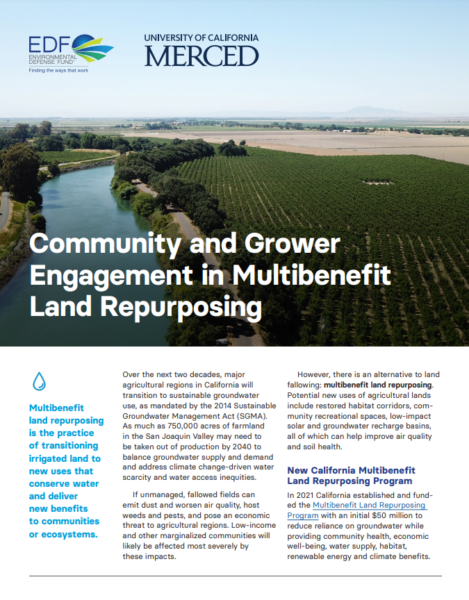 Many regions in California are embarking on a new era of water and land management strategies as local agencies implement sustainability initiatives and climate change intensifies droughts and water scarcity.
Many regions in California are embarking on a new era of water and land management strategies as local agencies implement sustainability initiatives and climate change intensifies droughts and water scarcity.
However, too often low-income rural communities have had little opportunity to influence land and water decisions that directly impact — and often harm — them, resulting in such outcomes as wells drying up and limited access to parks.
California’s new Multibenefit Land Repurposing Program aims to ensure these communities as well as small-scale farmers are more involved in land and water use planning by making their engagement a requirement for funding recipients.
Click here to read more from the Environmental Defense Fund.
RELATED EVENT: Office Hours: March 29: Repurposing farmland that will be fallowed as part of SGMA

UPCOMING EVENTS: Office Hours: Land repurposing, Proactive groundwater management strategies; Building conceptual models from airborne and ground electrical datasets; MAR as a strategy for mitigating drought impacts; and more …
March 29: Repurposing farmland that will be fallowed as part of SGMA
Join Mavens Notebook, the Groundwater Exchange, CivicWell (formerly the Local Government Commission) for the third in a series of groundwater lunch time “office hours.” These reoccurring sessions offer an informal forum to ask experts about Sustainable Groundwater Management Act (SGMA) implementation.
With the implementation of SGMA, estimates are that as much as 750,000 acres of farmland may need to come out of production to bring groundwater basins into balance. However, this doesn’t need to mean unproductive, dusty fields of weeds that worsen air quality. There are options! Potential new uses of agricultural lands include restored habitat corridors, community recreational spaces, low-impact solar and groundwater recharge basins, all of which can help improve air quality and soil health.
On March 29, our guests will be Anna Schiller, Project Manager with the Environmental Defense Fund, and Vicky Espinoza, UC Merced PhD Candidate and YouTube channel CaliWaterAg. They will provide an overview of a new program from the Department of Conservation that provides funding to help land repurposing projects be implemented, and discuss the new guidance document, Community and Grower Engagement in Multibenefit Land Repurposing.
Who should attend: Groundwater Sustainability Agencies (GSAs), beneficial users, tribes, researchers, non-governmental groups, and any other interested community member.
Submit your questions during the event or email them ahead of time to maven@mavensnotebook.com.
Click here to register.
April 4: Office Hours: Proactive groundwater management strategies
On April 4, we’ll be hosting Maurice Hall, Vice-President, Climate Resilient Water Systems, for the Environmental Defense Fund.
Maurice Hall leads EDF’s Water Program, focusing on developing collaborative water management approaches to meet ecosystem needs alongside the needs of farms and cities.
Accurate accounting of groundwater use is critical for effective management. EDF has co-developed an online water accounting platform, which is now being expanded through a partnership with the state, and OpenET, an online platform that makes satellite-based data on water consumed by crops widely access.
Join us on April 4, as we discuss OpenET, groundwater accounting and proactive water management to build resilience beyond SGMA.
Who should attend: Groundwater Sustainability Agencies (GSAs), beneficial users, tribes, researchers, non-governmental groups, and any other interested community member.
Submit your questions during the event or email them ahead of time to maven@mavensnotebook.com.
Click here to register.
March 31: WEBINAR: Electrical Hydrogeology: Building Aquifer Conceptual Models from Airborne and Ground Electrical Datasets
 The use of electrical data to provide denser datasets for conceptualizing flow and transport in aquifers is on the rise due to technology improvements and demonstrated cost effectiveness. Airborne electromagnetic (AEM) surveys provide large coverage of aquifer areas to detect regional scale flow paths and dominant fracture pathways.
The use of electrical data to provide denser datasets for conceptualizing flow and transport in aquifers is on the rise due to technology improvements and demonstrated cost effectiveness. Airborne electromagnetic (AEM) surveys provide large coverage of aquifer areas to detect regional scale flow paths and dominant fracture pathways.
Ground-based electrical resistivity imaging (ERI) surveys provide controlled higher resolution evaluation of potential drilling targets identified by AEM, to further quantify hydrogeologic parameters and assess validity of drilling targets. Temporal electrical resistivity imaging (TERI) can also be deployed to monitor and observe aquifer flow processes over time. As increasing amounts of data are collected and tested in a specific aquifer, the parameterization across the datasets becomes stronger over time.
This talk will illustrate the integration of airborne and ground electrical datasets with targeted traditional drilling/sampling data, to build robust conceptual models containing well defined preferential pathways at the regional scale.
Click here to register.
APRIL 6: WEBINAR: Managed Aquifer Recharge as a strategy for Mitigating Drought Impacts on Irrigated Agriculture in California
Managed aquifer recharge (or intentional recharge) is a purposeful human intervention designed to supplement natural enrichment processes of groundwater aquifers by various methods. It holds the potential to mitigate the impact of climate uncertainty on irrigated agriculture by replenishing storage levels in depleted groundwater sources, the economic value of which increases during droughts.
We use a high-resolution dynamic regional hydro-economic framework that endogenizes farming decisions in response to water quantity-quality changes, as well as complex hydrogeological principles to analyze several policy and climate scenarios applied to the Kings Groundwater Basin in California.
Our analysis demonstrates that intentional recharge is of benefit to the region, increasing in value under sustainable groundwater management derived from recent legislation in California. We also find that recharge strategy as well as the impact of climate uncertainty on regional welfare are sensitive to the prevailing institutional arrangements. Regional cooperation is essential, and its importance depends on climate conditions and existing policies.
Click here to register.
Find more groundwater events on the Groundwater Exchange’s calendar.

WEBINAR: How do you run a Groundwater Sustainability Agency ?– A Review of Choices made by Critically Overdrafted Subbasins
 On February 1st, 2022 Maven’s Notebook, the Groundwater Exchange, and the Local Government Commission hosted a webinar entitled: How do you run a Groundwater Sustainability Agency ?– A Review of Choices made by Critically Overdrafted Subbasins.
On February 1st, 2022 Maven’s Notebook, the Groundwater Exchange, and the Local Government Commission hosted a webinar entitled: How do you run a Groundwater Sustainability Agency ?– A Review of Choices made by Critically Overdrafted Subbasins.
Laura Ramos and Sarge Green from Fresno State discussed the key findings and recommendations of the newly released SGMA Governance Strategies Summary Report. If you missed the webinar, check out the recording to learn about the methodology and resources shared, along with the question and answer session.
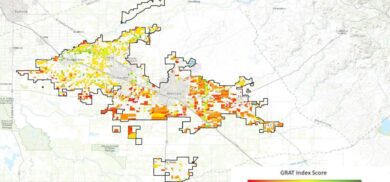
SUSTAINABLE CONSERVATION: Protecting Water Quality While Recharging Aquifers
 Over 600,000 Californians rely on nitrate-contaminated public supply wells for their household water needs. However, those numbers are even greater as they don’t include the many others who struggle with contaminated groundwater from domestic wells. Balancing long-term groundwater sustainability and water quality will help California weather future droughts, ensure safe drinking water, and support our thriving agricultural community that feeds the nation.
Over 600,000 Californians rely on nitrate-contaminated public supply wells for their household water needs. However, those numbers are even greater as they don’t include the many others who struggle with contaminated groundwater from domestic wells. Balancing long-term groundwater sustainability and water quality will help California weather future droughts, ensure safe drinking water, and support our thriving agricultural community that feeds the nation.
One tool for groundwater sustainability is groundwater recharge, where water is intentionally spread on the ground and allowed to infiltrate into the underlying aquifer. However, there is much concern that groundwater recharge can increase water quality issues, especially when the recharge water is spread upon agricultural lands.
In November of 2021, Sustainable Conservation held a webinar featuring a panel of experts who discussed how California can work to replenish our aquifers while protecting water quality for the health of our communities.

The deceptively simple plan to replenish California’s groundwater
From National Geographic:
“From afar, the rows of knobby grapevines blend into the landscape of pink-blossomed almond trees and fragrant citrus. But get up close and you’ll see something strange: The trunks of the vines are standing in several inches of glistening, precious water.
These grapes, at the Kearney Agricultural Research Center in California’s San Joaquin Valley, are part of a grand experiment that many hope will help solve the state’s deepening water crisis. Here, in the state that provides some 40 percent of all the fresh produce grown in the United States, a 20-year-long drought has left growers and communities desperately short of water. To make up the persistent shortfall from rain and snow, they are pumping groundwater—and doing so far faster than water can trickle down from the surface to replenish underground aquifers. … ”
Read the full story at National Geographic here (note: registration required): The deceptively simple plan to replenish California’s groundwater
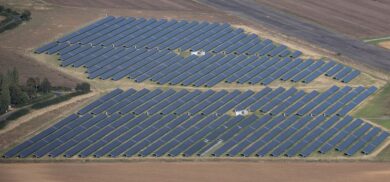
Could Solar Development Advance Groundwater Sustainability in the San Joaquin Valley?
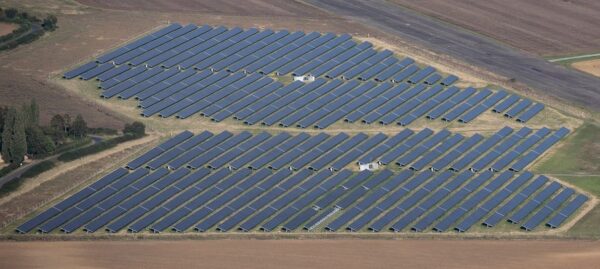 The San Joaquin Valley is facing a monumental shift in land use over the next two decades. Two important but seemingly unrelated laws are driving the change: the 2014 Sustainable Groundwater Management Act (SGMA), which aims to bring groundwater basins into balance by the early 2040s, and SB 100, which intends to help California achieve 100% clean power statewide by 2045.
The San Joaquin Valley is facing a monumental shift in land use over the next two decades. Two important but seemingly unrelated laws are driving the change: the 2014 Sustainable Groundwater Management Act (SGMA), which aims to bring groundwater basins into balance by the early 2040s, and SB 100, which intends to help California achieve 100% clean power statewide by 2045.
SGMA may require fallowing at least 500,000 acres of cropland in the San Joaquin Valley (10%) by 2040. A significant expansion of solar energy production to meet SB 100 goals, on the other hand, will demand a large amount of land. Promoting solar expansion on fallowed farmland in the San Joaquin Valley could support two major objectives at once: supporting the state’s clean energy goals while easing the economic pain of transitioning some land away from agriculture.
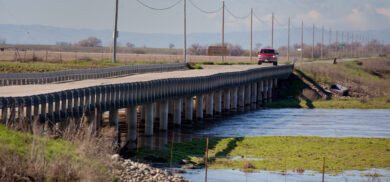
New Data Shows Subsidence Continued in Water Year 2021, But Pace Slower than Seen in Previous Droughts
 The California Department of Water Resources (DWR) released new satellite-based data that show subsidence – or the sinking of the land surface due to excessive groundwater pumping – continues in the state. DWR has intensified statewide subsidence monitoring to help identify impacts and address them collaboratively with local groundwater agencies, counties and landowners.
The California Department of Water Resources (DWR) released new satellite-based data that show subsidence – or the sinking of the land surface due to excessive groundwater pumping – continues in the state. DWR has intensified statewide subsidence monitoring to help identify impacts and address them collaboratively with local groundwater agencies, counties and landowners.
The areas experiencing the most subsidence during Water Year 2021 (WY 2021) are in the San Joaquin Valley, with a maximum of 1.1 feet of subsidence observed in the region and the Sacramento Valley with a maximum of 0.7 feet in the region. Data show that in WY 2021 subsidence of greater than 0.5 feet per year expanded to more areas than observed in WY 2020. However, fewer areas experienced higher rates of subsidence than at the end of the last drought in 2016.

SGMA in the News
Through challenges of drought, locally led solutions for groundwater sustainability are advancing
“California’s groundwater basins are a critical part of the state’s water supply for millions of people. Small communities rely on it, individual homes rely on it. It is a source of drinking water as well as irrigation for California’s agricultural community. Groundwater is a fragile lifeline for some communities and as we find ourselves entering a third year of a severe drought, conservation will be critical as many of the monitoring wells statewide now show groundwater levels below historical average. Despite this year’s dire drought circumstances, there is hope on the horizon for long-term groundwater sustainability and drought resiliency. That’s because California started taking action after the last drought. … ” Read more from DWR News here: Through challenges of drought, locally led solutions for groundwater sustainability are advancing
Drought continues and groundwater regulations heat up in California
“2021 was the driest year California has experienced in a century. At the end of the water year, spanning October 1, 2020 to September 30, 2021, the State received only 11.87 inches of precipitation, approximately half of average. This came on the heels of the second driest year on record in 2020. … While GSAs worked to draft and submit their GSPs, litigation followed as stakeholders challenged the approaches to basin management. Among the 42 GSPs that have been submitted to DWR, at least four are being litigated in California Superior Courts. So far, these lawsuits are not concentrated in a particular region of the State, with challenges in the Central Valley, Central Coast, and eastern desert regions. A common theme raised in each of the complaints is the allegation that the various GSAs violated SGMA by adopting GSPs that changed the rights and priorities of water rights holders within the basin areas. … ” Read the full post at Allen Matkins here: Drought continues and groundwater regulations heat up in California
California has begun managing groundwater under a new law. Experts aren’t sure it’s working
“In the rural county of Madera in California’s San Joaquin Valley, some farmworkers have learned to ration their water on a two-week schedule. Water gets hauled in by trucks and delivered to homes that have installed temporary tanks to store it in their backyards. Those cisterns usually hold up to 2,500 gallons, enough water to last a family two weeks, if they’re careful. The average California household uses double that in the same amount of time. “We’ve been using too much groundwater in the Central Valley that we really do not have, and it’s taking water from our communities now and from future generations,” said Erick Orellana, a policy advocate for the nonprofit Community Water Center. ... ” Read more from Inside Climate News here: California has begun managing groundwater under a new law. Experts aren’t sure it’s working
Water manager urges patience with SGMA
“Aaron Fukuda is frustrated with discussions in Sacramento over reforming water rights. Fukuda, who manages the Tulare Irrigation District and leads a local groundwater sustainability agency, explained his concerns to the State Board of Food and Agriculture during a meeting this week on the Sustainable Groundwater Management Act. He was specifically pushing back on a new white paper from a group of law scholars that encourages the Legislature to revise the state’s water laws to better account for drought and climate change. Fukuda argued that “opening up water rights” for fully appropriated streams would divert critical resources from sustainability projects to instead cover court fees, and “that, in my mind, is a bad place to be.” ... ” Read more from Agri-Pulse here: Water manager urges patience with SGMA
What every Californian should know about groundwater
“In honor of World Water Day—its theme is “Groundwater—making the invisible visible”—we asked a handful of PPIC Water Policy Center senior staff to discuss groundwater and drought in California. What should every Californian know about groundwater? Jeff Mount: Groundwater is our drought reserve, but we tend to treat it like a regular part of our water supply. It’s usually 30% of our water supply, but during drought it’s more than 60%. The problem is that we don’t reserve enough for droughts and use too much during wetter periods. Andrew Ayres: For a long time we treated groundwater like a property right, but it was a pretty lousy property right. A property right not only entitles you to access it but also excludes others from accessing it. That’s not what groundwater rights do in California. That is the source of many, if not all, of our groundwater problems. … ” Continue reading at the PPIC here: What every Californian should know about groundwater
NApa-Sonoma: State groundwater management may require metered wells, additional fees
“The lengthy, multifaceted work of the Sonoma Valley Groundwater Sustainability Agency reached a benchmark in December 2021 when its board approved a Groundwater Sustainability Plan (GSP) and sent it off to the state for review and potential approval. The plan, including references and appendices, came in at a hefty 1,285 pages, though attentive readers can get the gist in the 28-page executive summary. … Probably the most notable part of the plan is the section dealing with potential groundwater user fees and permits — necessary steps to assure the plan is viable and effective. … ” Read more from the Kenwood Press here: State groundwater management may require metered wells, additional fees
Westlands growers fear groundwater power grab by district general manager
“Divisions are deepening within the giant Westlands Water District as some growers fear the district’s longtime, controversial general manager is amassing too much power. In mid-February, district staff proposed new groundwater rules that would give General Manager Tom Birmingham almost total control over how groundwater is accounted for and to which grower accounts it would be credited, according to district growers. It was a move that shocked some and prompted a group of growers to send letters to the district opposing the rules and demanding fair governance. They say giving that much power to one staff person creates a situation ripe for favoritism and abuse. … ” Read more from Westlands Water District here: Westlands growers fear groundwater power grab by district general manager
Groundwater Management and Drought: An Interview with the San Joaquin Valley Partnership
The Department of Water Resources (DWR) is committed to working collaboratively with partners to provide data and tools and proactively address drought impacts on drinking water wells, as documented in the state’s Groundwater Management and Drinking Water Well Principles and Strategies framework. DWR has maintained a dry well reporting system since the last drought period from 2012-2016 in which several thousand dry well reports were received. DWR is assisting local counties and groundwater managers and working with partner organizations to prepare for and respond to drought-related water shortages. DWR Sustainable Groundwater Management Office representatives, Steven Springhorn and Melissa Sparks-Kranz, recently interviewed three women in leadership positions, advancing drought-related actions in the San Joaquin Valley: Laura Ramos, Associate Director for Research and Development at the California Water Institute, Lacey McBride, Water Resources Manager for Merced County and Tami McVay, Program Director-Partner Services at Self-Help Enterprises. … ” Continue reading at DWR News here: Groundwater Management and Drought: An Interview with the San Joaquin Valley Partnership
Tulare to drill new well with state funds
“Exeter and Tooleville are the latest communities to go through a state-mandated water consolidation, but not the first in Tulare County. In 2016, the state issued its first ever mandatory water consolidation between the city of Tulare and Matheny Tract, a rural community just west of the city limits. Now, six years later, Tulare is about to take the final step of the consolidation, building a new well with state money. Tulare Public Works Director Trisha Whitfield said the State Water Board notified the city on March 11 it has been approved for $4.28 million from the state’s Drinking Water State Revolving Fund Program to build Well 4-3, which will generate 1,000 gallons per minute for the city’s water customers, including about 1,500 people living in Matheny Tract. … ” Read more from the Foothills Sun-Gazette here: Tulare to drill new well with state funds
Tulare County to use mining pit to recharge aquifer with flood water
“… Working to reduce the long-term risks of natural disasters, the California Governor’s Office of Emergency of Services (Cal OES) announced last month it is applying for $250 million in federal funding for proactive projects preparing communities for emergencies instead of reacting to them. One project in Tulare County plans to reuse an excavated mining pit to recharge groundwater levels with floodwater, which would provide more water for irrigating crops and drinking water while also serving as a habitat for migratory birds. According to Cal OES, the project is requesting $16.27 million in federal funding for the nearly $23 million project. … ” Read more from the Foothills Sun-Gazette here: Tulare County to use mining pit to recharge aquifer with flood water
Using Sentinel-1 and GRACE satellite data to monitor the hydrological variations within the Tulare Basin, California
“Subsidence induced by groundwater depletion is a grave problem in many regions around the world, leading to a permanent loss of groundwater storage within an aquifer and even producing structural damage at the Earth’s surface. California’s Tulare Basin is no exception, experiencing about a meter of subsidence between 2015 and 2020. However, understanding the relationship between changes in groundwater volumes and ground deformation has proven difficult. We employ surface displacement measurements from Interferometric Synthetic Aperture Radar (InSAR) and gravimetric estimates of terrestrial water storage from the Gravity Recovery and Climate Experiment (GRACE) satellite pair to characterize the hydrological dynamics within the Tulare basin. … ” Read more from Nature here: Using Sentinel-1 and GRACE satellite data to monitor the hydrological variations within the Tulare Basin, California
Santa Ynez Groundwater Basin users could soon see new water-use restrictions
“The Santa Ynez River Valley Groundwater Basin runs from Lake Cachuma off Highway 154 out to the ocean near Lompoc. It’s used for urban water supply in Northern Santa Barbara County and in agriculture for things like wine grapes and vegetables. Now, water users in the area may be required to comply with sustainable tactics to help manage the basin after years of consistent drought and overuse. “Many parts of the basin are nearing historical lows,” said Santa Barbara County Water Agency Manager Matt Young. … ” Read more from the Santa Ynez Valley News here: Santa Ynez Groundwater Basin users could soon see new water-use restrictions
Santa Ynez Basin Groundwater Sustainability Plans approved
“Water conservation along the Santa Ynez River took a significant step in January 2022 when three agencies unanimously approved groundwater sustainability plans (GSPs). These plans will be the basis for groundwater management in the area through a 20-year implementation period. … Public agencies in the Santa Ynez Basin formed three GSAs (Eastern, Western, and Central) that cover the area from Lake Cachuma to the Pacific Ocean. These GSAs have been working since 2015 to prepare GSPs that describe the area’s geology, how much water is in the basin, how it moves through the basin, and how it is used. The GSPs also identify projects and management actions the GSAs will undertake to ensure the basin is managed sustainably. … ” Read more from the Santa Barbara Independent here: Santa Ynez Basin Groundwater Sustainability Plans approved
Ridgecrest: Indian Wells Valley water pumping 2.7 times higher than natural recharge
“The annual water report for 2021 was presented on Wednesday at the Indian Wells Valley Groundwater Authority regular board meeting. In short, water levels are declining. That much was already known, but questions revolved around gaps in the data. “We cannot be expected to control the overdraft until we understand the overdraft,” said Stan Rajtora, IWVGA board member representing the IWV Water District. The presentation was given by Stetson Engineers, the company performing the role of Water Resources Manager for IWVGA. … ” Read more from the Ridgecrest Independent here: Indian Wells Valley water pumping 2.7 times higher than natural recharge
Ridgecrest: Hard questions, fewer answers at public workshop on adjudication

“Members of the public turned up and asked hard questions at the Indian Wells Valley Water District’s adjudication workshop Wednesday night at city hall. Not all of them were answered. Questions ranged from potential impacts on small pumpers (unknown) to whether the adjudication outcome can be challenged after the fact (to some extent apparently). Questioners were polite and articulate, but frequently not reassured by the answers they heard. “I hope the judge doesn’t just say let’s cut that baby in half and give you each a half,” Skip Gorman said after asking about whether the determination can be questioned after the fact. … ” Read more from the Ridgecrest Independent here: Hard questions, fewer answers at public workshop on adjudication
Rosamond Community Services District halts efforts to use eminent domain
“The Rosamond Community Services District has halted its efforts to use eminent domain procedures to obtain water rights from agricultural land owned by the Calandri family on Rosamond’s west side. In November, the District Board of Directors unanimously approved a Resolution of Necessity, which declared it in the public interest to acquire the property for the water rights. On Wednesday, the Board rescinded that resolution, as the District had acquired other permanent water rights that meet a great deal of its water needs and temporary water rights that will provide a cushion while the effort continues to obtain permanent water rights, General Manager Steve Perez said. … ” Read more from the Antelope Valley Press here: Rosamond Community Services District halts efforts to use eminent domain
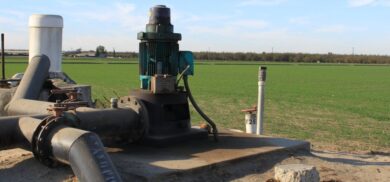
THIS JUST IN … DWR Releases Additional “Incomplete” Groundwater Sustainability Plan Assessments to Agencies, Initiating 180-day Timeline to Correct Deficiencies
From the Department of Water Resources:
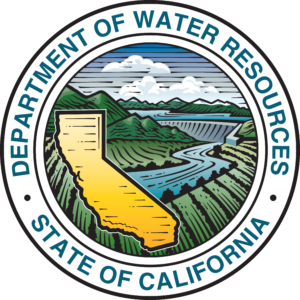 Today, the California Department of Water Resources (DWR) released eight determinations on groundwater sustainability plans (GSPs) developed by local agencies to meet the requirements of the Sustainable Groundwater Management Act (SGMA).
Today, the California Department of Water Resources (DWR) released eight determinations on groundwater sustainability plans (GSPs) developed by local agencies to meet the requirements of the Sustainable Groundwater Management Act (SGMA).
DWR has found in its technical review that the GSPs in eight basins contain deficiencies that preclude approval and the plans are determined to be Incomplete. The eight basins include the Eastern San Joaquin Subbasin, Merced Subbasin, Chowchilla Subbasin, Kings Subbasin, Kaweah Subbasin, Tulare Lake Subbasin, Tule Subbasin, and Kern County Subbasin, primarily located in the San Joaquin Valley.
The basins with GSPs that are determined Incomplete have 180 days from today’s release of DWR’s determination to address deficiencies and resubmit their corrected GSPs to the Department for review.
The determinations can be found on the Department’s SGMA Portal. For more information related to these GSP Assessments, please find the Frequently Asked Questions: Incomplete Determinations & Next Steps on our website. For questions, please contact the Sustainable Groundwater Management Office by emailing sgmps@water.ca.gov.
